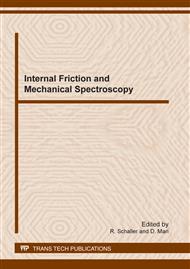p.197
p.203
p.209
p.215
p.221
p.227
p.233
p.239
p.245
Anelastic Effects on Martensitic Carbon Steels during First Stage of Tempering
Abstract:
The evolution of martensitic carbon steel during low temperature tempering was studied using internal friction. The steel containing 0.71wt.% carbon was heated at 1093K for 5min and then rapidly cooled into water (quenched), and tempered for 10 min at 340, 380, 420 and 460K. Additionally, other samples were tempered at 380K for 1 and 20 hours. Internal friction was measured by using a forced vibration pendulum, in a temperature range from 300 to 600K, with deformation amplitude 3 x 10-6 and temperature rate of 0.8 K/min. The internal friction spectrum is decomposed into three Debye peaks: P1 at 380K, P2 at 420K and P3 at 480K, for 3 Hz. P1 is attributed to the epsilon carbide precipitation. P2 and P3 are associated to the dislocation relaxation process. P2 appears when dislocations are pinning with epsilon carbide and P3 appears when dislocations are pinning with cementite carbide.
Info:
Periodical:
Pages:
221-226
Citation:
Online since:
January 2012
Authors:
Keywords:
Price:
Сopyright:
© 2012 Trans Tech Publications Ltd. All Rights Reserved
Share:
Citation:


